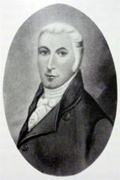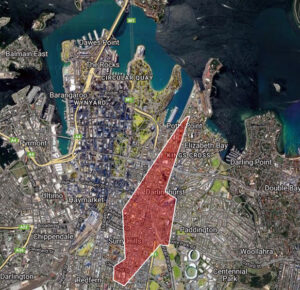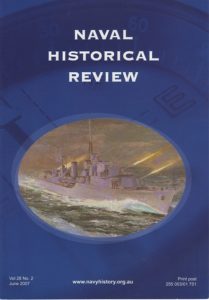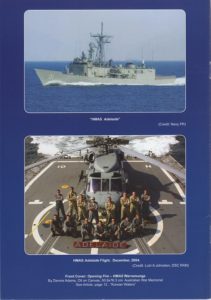By Cheryl Timbury.
This paper was first published on 6 February 2012 by the First Fleet Fellowship Victoria Inc ©.

John Palmer (1760 – 1833) the first Commissary-General of New South Wales, was born in England. Entering the navy, he had experience in the War of American Independence, during which he was for some time a prisoner, and while in New York in 1783 he married an American. In October 1786 he joined HMS Sirius as purser, voyaged in her to New South Wales with the First Fleet, and continued to serve in her until she was wrecked on Norfolk Island in 1790. In April of that year, he was appointed by Governor Phillip to be Commissary-General of the colony. He returned to England in 1796, and reached Sydney again in 1800, this time accompanied by his wife and family.
Francis Grose, while he was lieutenant-governor, granted Palmer 100 acres on the shores of what is now Woolloomooloo Bay, and there he built in 1801 a house reckoned on those days exceptionally luxurious, which was afterwards successively inhabited by Archdeacon Scott and Archbishop Polding. In this home Margaret Catchpole had in 1802 her first job in Australia as cook. Besides his public duties Palmer engaged in milling – Governor King gave him a mill-site close to Governor House, which much annoyed Governor Macquarie – and coastal trading. He owned in 1804 two 30-ton vessels which voyaged as far as Bass Strait, and a third smaller vessel which did not venture farther than the Hawkesbury River. He also owned farms purchased from other settlers (nearly 3000 acres in 1807), when he bred cattle and sheep and grew some wheat.
During the mutiny against Bligh, he sided with the Governor and was imprisoned by the Johnston-Macarthur party, but on Macquarie’s arrival was reinstated in his office until March 1810, when he was relieved from duty to proceed to England as a witness for Bligh. During his absence in England, Macquarie reorganized the department, and he returned in May 1814 to find himself merely an assistant-commissary-general, and that only because his knowledge was thought likely to be useful in recovering debts due to the Government. Macquarie, however, became dissatisfied with the whole department, and in January 1819 a fresh reorganization involved the retirement of Palmer on half-pay. By this time he had in one way and another lost all his estates except 100 acres at Parramatta and 1500 acres at Hambledon, near Rouse Hill, which had been granted him in 1818 as compensation when Macquarie resumed his land on the Hawkesbury for a township (Pitt Town).
After his retirement Palmer settled on his farm a Parramatta, was made a magistrate by Governor Brisbane, and became one of the Marsden-Blaxland-Macarthur circle; this led to his dismissal from the Bench through a quarrel between one of Brisbane protégés and the circle, but he was restored to it in 1825 just before Brisbane left the colony. The rest of his life seems to have been peaceful. He died at Parramatta on 27/9/1833, having survived all his fellow-officers of the First Fleet. His wife had died the preceding year, but he left children. Palmer Street, Sydney, is named after him.
Source:
Foster, Josephine John Palmer, J Roy. Aust. Hist. Soc., vol.11, 1925
The Australian Encyclopaedia (editor-in-chief, Alex H Chisholm), Sydney: Angus and Robertson, 1958
Death Notice
The Sydney Herald (NSW 1831 – 1842), Monday 30 September 1833, page 4
DIED – At his residence, Waddon, near Parramatta, on Friday, the 27th Instant, in the 74th year of his age, John Palmer, Esq., Assistant Commissary General, for many years, Principal Commissary of this Colony, and the last surviving officer of the first fleet that arrived in this part of His Majesty’s dominions.
The Reverend Samuel Marsden conducted the funeral service for John Palmer who was buried in the historical cemetery of St John’s, Parramatta. Palmer’s death certificate gives his quality of profession as a Gentleman, with no indication of the many offices he held and the part he played in the very early days of the colony. He now rests in a family crypt next to his wife, who had predeceased him by one year and to whom he had married for half a century.
Book-Plates Mirror the History of our States
The West Australian (Perth, WA: 1879-1954), Saturday 18 October 1952, page 27

Most people who amassed books, devise in the end the engraved label known as a book-plate which names the owner and is pasted into each book. The practice has lessened lately, but years ago it was common.
According to Barnett, one of the earliest book-plates brought to Australia belonged to one John Palmer. He came with the First Fleet in 1789 (sic) on the supply (sic) ship Sirius. Palmer entered the Navy at the incredibly early age of eight, but this apparently did not hinder him from becoming a man of culture.
The book-plate of John Palmer, who came with the First Fleet as purser in the HMS Sirius
Source: National Library of Australia web-site under TROVE
© First Fleet Fellowship Victoria Inc 2012.
Link to website entry, https://firstfleetfellowship.org.au/stories/john-palmer/
Further Reading
Steven, Margaret, Palmer, John (1760–1833) published by Australian Dictionary of Biography, available at, Link.

Left: Plan showing the allotments of 100 acres of land at Woolloomooloo to John Palmer, from the Crown in NSW.
This is an extract from an online re-creation of the Plan of the Settlements in New South Wales by Charles Grimes, Deputy Surveyor General, 1796.
This map created by CartoGIS, College of Asia and the Pacific, ANU, and the National Centre of Biography, College of Arts and Social Sciences, ANU, 2017 is available at, https://adb.anu.edu.au/entity/12454?pid=2533




